

TheMU - Risk Assessment for Freelance or Self-employed Members. Increasingly, members are being asked to provide Risk Assessments to those booking them and this is often being added into contracts.
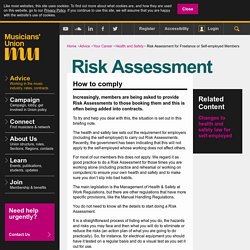
To try and help you deal with this, the situation is set out in this briefing note. The health and safety law sets out the requirement for employers (including the self-employed) to carry out Risk Assessments. Recently, the government has been indicating that this will not apply to the self-employed whose working does not affect others. For most of our members this does not apply. We regard it as good practice to do a Risk Assessment for those times you are working alone (including practice and rehearsal or working on computers) to ensure your own health and safety and to make sure you don’t slip into bad habits. The main legislation is the Management of Health & Safety at Work Regulations, but there are other regulations that have more specific provisions, like the Manual Handling Regulations. Example Risk Assessment Event Stage. Riskassessment2010. UK Suppliers of Pro Audio, Lighting, Staging, PA, AV, Noise Limiters and more. Noise & Sound Control Overview (Sound Limiters & Warning Signs) A sound limiter, also known as environmental noise control systems, is now a requirement in many areas of the UK for the granting or renewal of an entertainment licence.
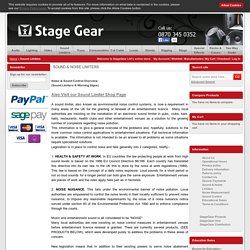
Many local authorities are insisting on the installation of an electronic sound limiter in pubs, clubs, bars, halls, restaurants, health clubs and other entertainment venues as a solution to the growing number of complaints regarding noise pollution. This information is to give a general overview of the problems and, hopefully, solutions to the more common noise control applications in entertainment situations. Full technical information is available. The information is not intended to be an answer to all problems as some situations require specialised solutions. 1: HEALTH & SAFETY AT WORK. 2: NOISE NUISANCE. Sound Advice Note 11 Amplified music in pubs and clubs. Exposure to noise 11.1 This advice provides methods of controlling the risk of hearing loss in venues where amplified music is played, including nightclubs, bars, pubs and restaurants.
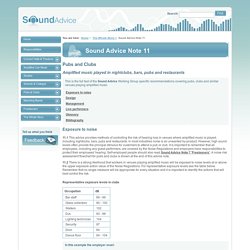
In most industries noise is an unwanted by-product. However, high sound levels often provide the principal stimulus for customers to attend a pub or club. It is important to remember that all employees, including any guest performers, are covered by the Noise Regulations and employers have responsibilities to protect their employees' hearing. Self-employed people should also read Sound Advice Note 7 'Freelancers'. 11.2 There is a strong likelihood that workers in venues playing amplified music will be exposed to noise levels at or above the upper exposure action value of the Noise Regulations. Representative exposure levels in clubs Design 11.3 Methods of reducing noise in work areas can be split into two categories - physical separation and focusing the music in the desired locations. Physical separation. Health and safety advising at a music festival.
17 ways for musicians to stay safe when performing at festivals - Andy Reynolds's Live Music Business. One of the many things to consider is that festivals operate on almost split-second timing; festival promoters are subject to very heavy financial fines if they run past an agreed-upon sound curfew.
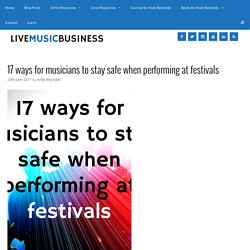
Bands performing at festivals are therefore given a strict time to be onstage and offstage, with another set time for changeover (getting the previous act’s gear off and their gear on). The pressure is on you to get on stage, play and get off in your allotted time and with all that rushing around it is easy to forget about health and safety. So, I do not want to come across as being like your mother, but please be careful up there onstage – there is a lot of electricity in those cables and a lot of things to bump into or fall off, so watch yourself! To explain a bit further, I have compiled the following dos and don’ts when it comes to stage safety, all based on (sometimes bitter) experience. Health and safety. Emma Webster considers what to do if an audience member is taken ill or is injured at a live music event and whose responsibility it is at events to look after and treat audience members in need.
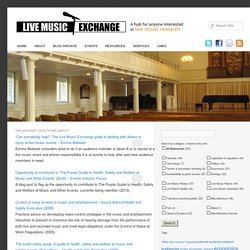
A blog post to flag up the opportunity to contribute to The Purple Guide to Health, Safety and Welfare at Music and Other Events, currently being rewritten (2013). Practical advice on developing noise-control strategies in the music and entertainment industries to prevent or minimise the risk of hearing damage from the performance of both live and recorded music and meet legal obligations under the Control of Noise at Work Regulations (2005).
Affectionately referred to by many as ‘The Purple Book’, the Event Safety Guide aims to help those who organise music events so that the events run safely, bringing together information needed by event organisers, contractors and employees to help them satisfy legal requirements. Events health and safety. TheMU - Health and Safety - The Basics. The demands of the music industry often place a range of pressures on musicians, which can sometimes result in physical or psychological strain.The MU knows this and the Union is fully committed to ensuring that the health, safety and welfare of its members are maintained.
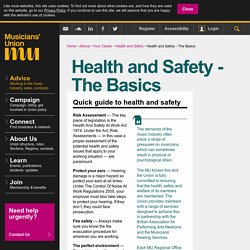
The Union provides members with a range of services designed to achieve this in partnership with the British Association for Performing Arts Medicine and the Musicians’ Hearing Services.Each MU Regional Office is set up to deal with health and safety issues and members should use theirs as the first point of contact for assistance and guidance.Dave Webster, MU National Organiser, Live Performance Risk Assessment — The key piece of legislation is the Health And Safety At Work Act 1974.
Under the Act, Risk Assessments — in this case a proper assessment of the potential health and safety issues that apply to your working situation — are paramount. Look after yourself — Be proactive in your health. Airsweb.